Ford Generator Regulator Wiring Diagram P5w

These Kohler Engine Rectifier/Regulators Are NOT the Same!
by Bob Thomas

Solving Problems When Using Stator-Activated Regulators
by Bob Thomas

Denso's Brushless Alternator
by Bob Thomas

Often Confused and Cross-Referenced � They Do Not Interchange
by Bob Thomas

COM Terminal Alternator Systems Explained
by Mario Cespedes

Options Available for Testing COM System Alternators
by Bob Thomas

Valeo Alternators Used on Sprinter Vans
by Bob Thomas

Testing Kokusan-Denki Alternators
by Bob Thomas

This document explains the differences between two look-alike Delco alternators that are nearly identical and may even interchange in some cases. However, one is A-circuit and the other is B-circuit. The regulators and rectifiers look nearly identical but will not interchange.
by Bob Thomas

While recently answering the ERA Tech Help Line for Scott Scharrer who was on vacation, I was asked for help in finding a part that was described to me as a 3-wire spider resistor for a 36SI.
by Ken Plourde

2013 Ford F-150 Lariat Pickup Truck with low battery Condition.
Replacing Alternator.
Repairing alternator and using a Valeo FG15S090.
by Ken Plourde
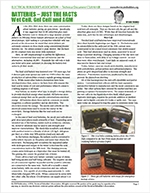
This document explains the differences between the various battery types used to crank vehicles.
It includes the common wet cell, gel cells, absorbed glass mat (AGM) and lithium-ion batteries.
by Bob Thomas

This self-calculating worksheet will help you select an alternator with the correct output. It includes sample values for most all electrical loads on a vehicle.
Simply type in the quantity of each load and the worksheet will calculate the total electrical load for you!
ERA membership is required to download. Join Today!by Wes Grueninger, Sr.

This chart lists and translates voltage regulator terminal codes for most all manufacturers voltage regulators.(54K PDF)
ERA membership is required to download. Join Today!by Scott Fureman - Purfex Electrical Distributors

The Delco-Remy Auto-Start trio was initially introduced with the 22SI alternator and has been around for over 17 years. However, many rebuilders may still not know how to test one. The Auto Start is basically a package of three components: a diode trio, a capacitor and an electronic circuit that senses stator voltage and applies excitation voltage to the field. This two-page article will show you how to verify all funtions of an auto-start trio system
ERA membership is required to download. Join Today!by Bob Thomas

This handy chart displays the proper time/amps to bring a discharged battery to a full charge. It's great to hand out to customers.(5K PDF)
ERA membership is required to download. Join Today!courtesy Mike Schroeder

Charging multiple batteries through an isolator can present problems if the load on the batteries is significantly unbalanced, which is generally the case. We will explain the problems that can arise and a viable solution, using an example that is common to many of the vehicles used by Snap-On, Matco, or Mac tool truck dealers.
ERA membership is required to download. Join Today!by Wes Grueninger, Sr. and Bob Thomas

This document covers several common problems you might encounter using a stator-activated self-exciting voltage regulator
ERA membership is required to download. Join Today!by Bob Thomas

This four page article gives tips and tricks for rebuilding and testing the brushless, internally-regulated alternator used on many Belarus tractors. It also includes information on using commonly available parts to replace hard-to-find OE parts.
ERA membership is required to download. Join Today!by Wes Grueninger, Sr. and Bob Thomas
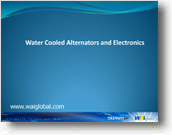
Bosch Alternators
This presentation is available as an on-screen slideshow and as a printable PDF.
Topics include:
- Why water cooling?
- History of water cooling
- Bosch family of water-cooled alternators
- Component parts description
- Common failure modes and their solutions
- Regulator pin-outs and Transpo replacement regulators
ERA membership is required to download. Join Today!
courtesy WAI - Online Slideshow by Wes Grueninger, Sr.

This article describes the Delphi liquid cooled alternators used by Cadillac (Lester 8236 and 8294). Wiring diagrams are included.(1,170K PDF)
ERA membership is required to download. Join Today!by Wes Grueninger, Sr.

What, Where, Why and How
Anyone who has ever dismantled an alternator has probably noticed a capacitor. Sometimes it is mounted on the outside of the housing, looking like it was put there as an afterthought. Nowadays it is more often hidden deep inside one of the other alternator components. What is a capacitor anyway? Why is it there? What does it do? How does it do it?
This three-page article answers all of those questions.
ERA membership is required to download. Join Today!by Bob Thomas
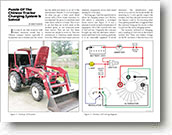
The ammeter indicated no charging, and a reading of 12.6 volts at the battery verified this. There was battery voltage on the B+ terminal of the alternator, but there was no voltage on the field terminal with the engine running.
This three-page article Will show you the problem and the fix.
ERA membership is required to download. Join Today!by Bob Thomas

From "A" Circuit to"B" Circuit
Chrysler has changed from "A" circuit to "B" circuit charging systems. This one-page guide explains current flow through both systems.(324K PDF)
ERA membership is required to download. Join Today!by Wes Grueninger, Sr.

Check The Remote Jump Post
An oxidized/corroded connection at the jump post can cause an overcharge condition. This short article describes the trouble spot and the fix.
ERA membership is required to download. Join Today!by Larry Hagemeister

Next Generation Controller
A rubbed-through wire caused intermittent charging on a 2005 PT Cruiser. Mohammad Samii walks you through how he diagnosed and repaired the problem. 3-pages
ERA membership is required to download. Join Today!by Mohammad Samii

Tips for diagnosing repeated failure.
ERA membership is required to download. Join Today!by Bob Thomas

Chrysler was one of the first automakers to use alternators. They made the complete switch from generators to alternators in 1961. This first system used a single field-terminal alternator with an external mechanical B-circuit voltage regulator, and it remained unchanged until 1970. In 1970, Chrysler changed to a dual field terminal alternator with an external electronic A-circuit voltage regulator. This system was used until the mid-1980s when the voltage regulator was moved inside the engine's electronic control module. 6-pages
ERA membership is required to download. Join Today!by Wes Grueninger, Sr.

This two page article discusses the function of the alternator "C" terminal used on 2005 and up Nissan and Infiniti vehicles. The "C" terminal no longer functions as it has in the past. Testing procedures and a wiring diagram are included (89K PDF)
ERA membership is required to download. Join Today!by Rich Herrington (AmFor Electronics)

All of the information that you need to rebuild a 24SI is contained in this document.
ERA membership is required to download. Join Today!By: Bob Thomas

This is the first in a series of documents on Denso's Segment Conductor (SC) Alternator, one of the most widely used alternators in North America today.
ERA membership is required to download. Join Today!By: Bob Thomas

This second part of the Denso SC series. It covers rotor and stator combinations that can be easily confused during rebuilding. Each different stator is described using pictures and diagrams to help you identify them. Mismatched rotors may pass a bench test but fail to perform properly on a vehicle.
ERA membership is required to download. Join Today!By: Bob Thomas
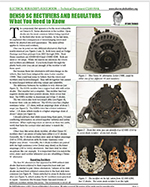
This third and final document of the Denso SC series covers rectifiers and regulators. It pays special attention to two alternators that have the same Lester number, will interchange and look nearly identical - yet the rotor, stator and rectifier are all slightly different and cannot be interchanged between units without creating problems. If you get them mixed up, this document explains how to tell them apart.
ERA membership is required to download. Join Today!By: Bob Thomas

Direct from the OE Manufacturer, this sheet provides proper testing procedures and methodology to prevent damaging the new ASVR (All Silicon Voltage Regulator) regulators being used in GM's CS-series alternators.(28K PDF)
ERA membership is required to download. Join Today!courtesy Taditel

This guide provides specifications and cross reference information for regulators used in CS-series and AD-series alternators.(57K PDF)
ERA membership is required to download. Join Today!courtesy Regitar

This article talks about a tip that you can use when dealing with the Delco Remy 44G Battery Post Spacer Fix.
ERA membership is required to download. Join Today!By: Larry Hagemeister

From 1977 this six-page guide gives torque specifications for 20DN, 30DN, 50DN, 25SI, 30SI and 40SI alternators. It also includes thread and screw measuring tips.
ERA membership is required to download. Join Today!courtesy AC-Delco
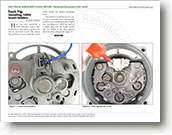
This handy guide will show you how to achieve perfect brush holer alignment every time. 1-page
ERA membership is required to download. Join Today!by Bob Thomas

Lestek to Balmar
Because the 10DN design was both reliable and versatile, many of those alternators are still in use today. Typically, they use heavy duty 50 or 70 amp, 1/2-inch press-fit diodes, with braided leads connected to the stator terminals. Whenever you encounter one of these for rebuilding, the biggest difficulty is getting good connections between the diode stems and the stator terminals.
This 3-page article will show you how to replace the diodes and how to connect the diodes to the stator using good, solid connections
ERA membership is required to download. Join Today!by Bob Thomas

While all of the Delco mechanical voltage regulators that were originally used with the 10DN looked nearly identical, there were, in fact, three different regulators. Each one functioned a little differently, depending on the specific charging system circuit with which it was used.
This 4-page photo guide, complete with wiring diagrams, explains what makes each system unique.
ERA membership is required to download. Join Today!by Bob Thomas
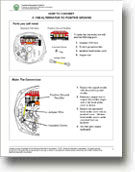
Standard Regulator: This guide shows how to convert a 10SI alternator to postive ground and how to use a relay to control alternator turn-on.
ERA membership is required to download. Join Today!Stator-Activated Regulator: This guide shows how to convert a 10SI alternator to postive ground and how to use a relay to control alternator turn-on.
ERA membership is required to download. Join Today!by Wes Grueninger, Sr.

Delco-Remy 21SI and 22SI alternators have been around for many years, but they look similar enough on the outside that some rebuilders still get them confused or find it difficult to differentiate between them. This article will explain the differences between the two, why the 22SI replaced the 21SI and some common problems that you might encounter rebuilding them
ERA membership is required to download. Join Today!by Bob Thomas
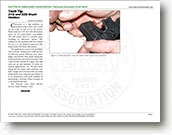
This short article will show you how to stop corrosion on brush leads.
ERA membership is required to download. Join Today!by Ken Plourde

This article was created using slides from Joe Davis' 2005 seminar series. It shows a simple and reliable way to remove broken screws from aluminum housings - without drilling!(448K PDF)
ERA membership is required to download. Join Today!courtesy Joe Davis and Joe Bradish

This 3-page article examines the 22SI alternator equipped with an oval-plug voltage regulator. Includes discussion about fitment, insulators and straps, regulator turn-on and regulator testing.
ERA membership is required to download. Join Today!by Bob Thomas

Alternator Service Test Specifications 1978-1984
Use this guide to find information about Delco-Remy alternators from the OE number.
Information includes:
- Series
- Type
- Ground
- Service Bulletins
- Rotation
- Spec. No.
- Field Current Amps and Volts
- Cold Output
- Hot Output

Two-Unit Regulators (D635)
The D635 is the most common regulator, and it was used on all vehicles, tractors and equipment that had a charge indicator lamp. All four terminals are used.
This 6-page service bulletin from 1966 covers operating principles and troubleshooting procedures.
ERA membership is required to download. Join Today!
Two-Unit Regulators (D632)
The D632 was used only on vehicles and equipment that had a gauge instead of a charge indicator lamp. This included performance cars of the 60s, trucks, many farm tractors and some industrial equipment. Lacking a part number, this system can be identified by the number of wires in the harness at the regulator plug. Only three of the four terminals are used.
This 5-page service bulletin from 1966 covers operating principles and troubleshooting procedures.
ERA membership is required to download. Join Today!
Single-Unit Regulators (D633)
The D633 is the least common of the three 10DN voltage regulators. It is a single-unit regulator, meaning that it did not contain a field relay and was a much simpler circuit design. It was used primarily on some Pontiac models between 1963 and 1968, including the first Firebirds. It was also used on some White and Oliver tractors. All of these applications had gauges, and none had charge indicator lamps. Only two wires were used in the harness plug with the D633. This regulator can be easily identified because it has only three terminals, not four. Terminal two is missing.
This 5-page service bulletin from 1966 covers operating principles and troubleshooting procedures.
ERA membership is required to download. Join Today!
This three-page article explains the so called "Mickey Mouse" connection and the problems it can cause. Various ways to salvage used rectifiers and regulators are covered. The evolution of AD regulator styles is discussed
ERA membership is required to download. Join Today!by Bob Thomas and Wes Grueninger, Sr.
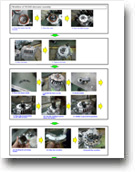
SRE Assembly Flow Chart
This picture-guide shows all of the steps involved in assembling a CS130D SRE
ERA membership is required to download. Join Today!courtesy Bill Ernst / WAI

Slip-Ring Replacement
This four-page article shows the tools and techniques needed to successfully replace the slip-rings on Denso hairpin alternator rotors.
ERA membership is required to download. Join Today!by Bob Thomas and Wes Grueninger, Sr.

This chart contains all known regulators used in Denso internal-fan alternators (as of 05/2004). List is broken down by OE regulator number and lists pinouts, voltage set point, L terminal functions, load response control, and more.(46K PDF)
ERA membership is required to download. Join Today!by Alan Melton - Northwest Regulator Supply

The terms, "avalanche diode" and "Zener diode" have been confused at times and even interchanged in error. Although they are similar in what they do, they are also very different in several ways. We will attempt to explain those differences along with where and why each diode is used in alternators today.
ERA membership is required to download. Join Today!by Bob Thomas

Have you ever wondered... In one word the answer is heat, but there is more to ie than that. This article expalins what types od heat and other factors that lead to Diodes failing.
ERA membership is required to download. Join Today!by Bob Thomas

When diode leakage is too high, it can keep a stator-activated regulator turned on after engine shut down, because this type of regulator is always looking for stator voltage. Rebuilders who have been using AC-activated or stator-activated regulators in self-exciting alternators may have encountered leakage problems without knowing it. This three-page article shows a simple test that will eliminate diode leakage problems.
ERA membership is required to download. Join Today!by Wes Grueninger, Sr. and Bob Thomas
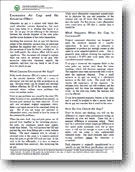
Alternator air gap is a subject with which few small rebuilders concern themselves, but most have been bitten by it, whether they know it or not. By air gap, we are referring to the clearance between the outside diameter of the rotor poles and the inside diameter of the stator laminations. This three-page artice discusses the effects of a large air gap - low output and decreased regulator life. It includes test data from two different controlled experiments.
ERA membership is required to download. Join Today!by Wes Grueninger, Sr. and Bob Thomas

Selecting the correct rectifier to use with with a PCM-controlled regulator
This one-page guide explains how to tell the difference between the two styles of Ford 4G rectifiers. It includes photos and wiring diagrams.(1418K PDF)
ERA membership is required to download. Join Today!by Wes Grueninger, Sr.
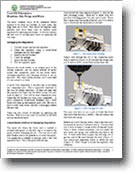
The most common cause of 6G alternator failure appears to be worn out brushes. In most cases, slip rings wear out as well. This 6-page, fully illustrated article explains methods that have been used to reclaim good regulators by replacing the brushes. It also explains the best way to salvage good rotors by replacing the slip rings. Stator and SRE bearing removal are also discussed.(3.6MB PDF)
ERA membership is required to download. Join Today!by Wes Grueninger, Sr. and Bob Thomas

Understanding Ford 6G Alternator Rectifiers
Choosing the correct rectifier has never been as important as it is with the Ford 6G series alternators. This 5-page guide explains the characteristics that separate the different part numbers.(1117K PDF)
ERA membership is required to download. Join Today!by Wes Grueninger, Sr. and Bob Thomas
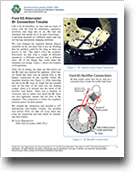
B+ Connection Problems
This one page article explains how corrosion at the B+ stud-to-rectifier connection can cause charging problems for 6G alternators.
ERA membership is required to download. Join Today!by Wes Grueninger, Sr. and Larry Hagemeister

PCM-Controlled and Non-PCM-Controlled
This six-page guide explains how Ford 6G voltage regulators operate. It includes wiring diagrams of typical 6G charging systems and explains how the voltage regulator functions in each type of system. Color codes and OE numbers are included for all known North American applications as of January, 2008. This article has been updated and expanded in the companion piece Ford 6G Update: Troubleshooting Warning Lamp Problems shown directly below
ERA membership is required to download. Join Today!by Wes Grueninger, Sr. and Bob Thomas

Troubleshooting Warning Lamp Problems
This five-page guide explains how to diagnose and repair problems with the charge lamp used in Ford 6G charging systems. It includes wiring diagrams of typical 6G charging systems and explains how the voltage regulator and charge light functions in each type of system. This article is a companion piece to the article Ford 6G Regulators: PCM-Controlled and Non-PCM-Controlled show directly above.
ERA membership is required to download. Join Today!by Wes Grueninger, Sr. and Bob Thomas

2004–2007
The 6.0 liter Ford Powerstroke diesel engine with the dual alternator package consists of an upper and a lower alternator. The upper alternator is a 140-amp Visteon 6G, Lester #8478. The lower alternator is a 120-amp Visteon 4G, Lester #8477. These alternators are not interchangeable and were used only on Ford Super Duty applications with dual alternators from 2004 to 2007.
This 2-page guide discusses the types of alternators and regulators used in this charging system and how they interface with the PCM.
ERA membership is required to download. Join Today!by Ken Plourde

2008–2010
The 6.4L Powerstroke™ diesel engine with dual alternators was an option from 2008 to 2010 on Ford truck models from the F-250 to F-550 and some E-Series vans. The dual alternator systems were largely used on vehicles destined for conversions to special applications, like emergency response vehicles or shuttle buses. It is comprised of an upper and a lower alternator.
This 2-page guide discusses the types of alternators and regulators used in this charging system and how they interface with the PCM. A wiring diagram is also included.
ERA membership is required to download. Join Today!by Ken Plourde and Wes Grueninger, Sr.
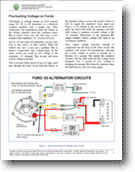
Fluctuating or pulsing voltage on Ford vehicles using 2G, 3G or 4G alternators is a relatively common problem with a simple cure. Most technicians will immediately place the blame on the voltage regulator when this condition exists. But in nearly every case, the real cause is low voltage at the regulator's "A" or sense terminal. This two-page guide will show you how to identify and repair the problem, whether it exists on a vehicle or on your test bench.
ERA membership is required to download. Join Today!by Wes Grueninger, Sr. and Bob Thomas

(Regulated Voltage Control System)
General Motors introduced their Regulated Voltage Control charging system on 2004 Cadillac CTS and SRX models. It is now being used on most of their current applications. RVC has taken voltage control to a new level. This seven-page article discusses the purpose and reasoning behind RVC and the two styles of RVC systems (integrated and stand-alone). It includes descriptions of RVC system components and how they interact. You will learn to recognize the six different RVC system operating modes. Test procedures on the vehicle, as well as on the test bench, are covered. Wiring diagrams of typical integrated and stand-alone versions are included.
ERA membership is required to download. Join Today!by Wes Grueninger, Sr. and Bob Thomas

General Removal & Installation Procedures
This presentation is available as an on-screen slideshow and as a printable PDF.
Topics include:
- Removal Procedures
- Installation Procedures
- Pulley, Belt and Tensioner Inspection
- Prevent cracked housings - proper alternator mounting and bolt tightening
- Testing charging system after installation
ERA membership is required to download. Join Today!
courtesy WAI - Online Slideshow by Wes Grueninger, Sr.

A repeated complaint regarding this problem, particularly with the 13649 or 13674 alternator used in the mid to late 90s and into early 2000, is that the replacement alternator does not charge. This articles shows how to diagnose and repair the problem
ERA membership is required to download. Join Today!by Mohammad Samii

For many years Honda and Acura have utilized a dual mode charging system to increase fuel efficiency and to decrease the drag on the engine when starting. This article explains all components of the system and teaches how to diagnose problems. DTC's are included.
ERA membership is required to download. Join Today!by Omar Trinidad, Southern Illinois University Carbondale

Testing Solutions and Wiring Diagrams
This two-page guide explains how to adapt a hardware-store pulley for testing these alternators. It includes motorcycle wiring diagrams and test bench hookup instuctions(495K PDF). For more information about Honda Goldwing alternators and starters see the repair manual listed below.
ERA membership is required to download. Join Today!by Wes Grueninger, Sr. and Bob Thomas

Testing and Repairing the Charging and Starting Systems
This 76-page excerpt from the factory service manual covers all aspects of the charging and starting systems. This is a large download!(10.5mb PDF)
ERA membership is required to download. Join Today!courtesy Honda Motor Company

A strange capacitor-looking component that is being mounted on the back of some Iskra/Letrika alternators is not a capacitor at all, in spite of the fact that it is being called that in printed literature.
It is an inductor.
This 2 page article discusses what it is, why it's there, how it works and how to test it.
ERA membership is required to download. Join Today!by Bob Thomas

With 4BD1, 4BD2 4-Cylinder Diesel Engines
The NPR charging system has several unique features that make it difficult to test and diagnose. This guide will show you how to successfully test and rebuild the alternator and how to identify problems in the vehicle's electrical system. It specifically deals with LR170-410B and LR170-418B alternators. (3.28MB PDF)
ERA membership is required to download. Join Today!by Wes Grueninger, Sr.

If the charge indication lamp flashes every 8 seconds on John Deere small farm/utility tractors or John Deere Gator utility vehicles, this one-page guide will explain how to fix the problem.
Four Lester numbers are affected: 12080, 12081, 12353 and 12354.
Updated January, 2013
ERA membership is required to download. Join Today!by Wes Grueninger, Sr. and Bob Thomas
 View a video with more information about this topic in the ERA Video library
View a video with more information about this topic in the ERA Video library

Leece-Neville 8SC Series Batteryless Alternators are, as the name implies, designed to provide power to electrical systems that do not include a battery. This sounded strange to us, too, but they are out there on the road, installed primarily to power refrigeration systems for trucks and air conditioning units on large buses and motor homes.
This 2-page article will show you how the system works and how to test it.
 View a video with more information about this topic in the ERA Video library
View a video with more information about this topic in the ERA Video library
by Bob Thomas and Wes Grueninger, Sr.

Models covered by this procedure: 8SC3017VA (110-575) 24 volt excite, 8SC3018VA (110-576) 12 volt excite, 8SC3200V, and 8SC3127V.
All of the models listed above are designed to operate only air conditioning systems without the aid of batteries.
These alternators have no internal voltage sensing capabilities so they require a special method of testing or the voltage will run away causing damage to the regulator.
courtesy Leece-Neville
 View a video with more information about this topic in the ERA Video library
View a video with more information about this topic in the ERA Video library
NOTE: Leece-Neville has updated the test procedures described in the article above.
Be sure to read this update before testing any Leece-Neville batteryless alternators.
ERA membership is required to download. Join Today!

Converting To External Sense For Use With A Battery Isolator
Two-page article
ERA membership is required to download. Join Today!by Bob Thomas

This two-page article discusses the John Deere 2500E Hybrid Greens Mower. It includes a description of the 48-volt alternator and how it powers the electric reel motors. Testing procedures as well as a system wiring diagram are included. (675K PDF)
Revised with new information and new test procedures July, 2012
ERA membership is required to download. Join Today!by Wes Grueninger, Sr. and Bob Thomas

This four-page article discusses load balance problems inherent in multiple-alternator installations. It goes on to explain the flaws of the earlier Leece-Neville X2 system and how it was superseded by the MultipowerTM system. It includes an explanation of the TxRx regulator and provides complete diagnostics for the system.
ERA membership is required to download. Join Today!by Wes Grueninger, Sr. and Bob Thomas
 View a video with more information about this topic in the ERA Video library
View a video with more information about this topic in the ERA Video library
 Read a technical bulletin from Leece-Neville about this procedure.
Read a technical bulletin from Leece-Neville about this procedure.

This PDF consists of three Leece-Neville factory guides from 1979:
- Form 3688—Wiring diagrams and testing instructions for 5114T and 5116T transformer-rectifiers.
- Form 3978—Mounting the 5114T transformer-rectifier-circuit breaker kit on Leece-Neville 2500J, 2600J 2700J series alternators.
- Form 4039—Mounting the 5116TA transformer-rectifier-circuit breaker kit on Detroit Diesel flange mounted alternators.
courtesy Prestolite/Leece-Neville

This four page reference guide crosses the "9801-" Lester Plug Codes to JIMCO Test Leads/Test Boxes.
Updated! October 2012
ERA membership is required to download. Join Today!courtesy JIMCO Inc.

Test it right - use the correct test lead. This 29-page guide references Lester alternator numbers and lists the correct test lead to use. Print up a copy to keep by your test bench!
Updated 12-2012
ERA membership is required to download. Join Today!courtesy of Alan Melton, Northwest Regulator Supply

Thermistor battery sense on Ford Tractors
There were only two different regulators that were used with the 12 volt A127 alternators. One was internally sensed, and the other was externally sensed through a thermistor at the battery (using the terminal at the end of the orange wire). The latter is the regulator that causes the most problems for rebuilders and their customers. That is the one we will focus on here. It was used on many applications after 1989.
ERA membership is required to download. Join Today!by Bob Thomas and Wes Grueninger, Sr.
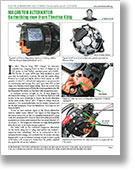
Something new from Thermo King
In 2011, Thermo King changed its alternator manufacturer, dropping Bosch in favor of Magneton, for DC power on their TriPac™ auxiliary power units (APUs). For the last 15 years, APUs have been installed on most new over-the-road trucks to reduce the need for engine idling. Powered by a small and highly efficient diesel engine, an APU provides 12 volts DC, 120 volts AC and powers a compressor for air conditioning and heating.
If you bench test this alternator, it will not charge unless you ground the F terminal. To make it operate on the APU, the F terminal must be grounded with a jumper wire (there is one exception that is explained in the article). Who would expect a terminal labeled F to require a ground wire? ... (2 pages)
ERA membership is required to download. Join Today!by Ken Plourde and Bob Thomas

One of the most common failure points in Mitsubishi rectifiers has nothing to do with the diodes. It is a poor or failed positive heat-sink-to-B+ connection. When you test the diodes in this type of rectifier, test from the diode stems to the heat sink. If they all test good and you plan to reuse it, you must inspect and clean the heat-sink-to-B+ connection. This article shows you how. 2-pages
ERA membership is required to download. Join Today!by Bob Thomas

The small-case Motorola alternator, built in the early 1960s was used extensively on countless agricultural, marine and industrial applications, in addition to AMC vehicles. Amazingly, it is still being manufactured in the US by Prestolite, in multiple configurations, under the Leece-Neville brand. The basic platform and design have withstood over 50 years of progress. Some newer versions may have more advanced regulator circuitry, but the basic alternator is, for the most part, unchanged.
ERA membership is required to download. Join Today!by Wes Grueninger, Sr.

Often, the bearings and stators on the 555 Motorola alternators, (also branded as Leece Neville or Prestolite) hold too tightly to easily separate the housings. I needed a way to support the alternator by the SRE housing in my arbor press in order to push the SRE bearing out of the housing. This article shows what I came up with.
ERA membership is required to download. Join Today!by Nathan Unger

with "A" circuit regulation
What makes these alternators unique is not so much the A-circuit regulator, but the source of field current, which comes directly off of the stator. This guide will show you proper bench testing procedures for the alternator.
ERA membership is required to download. Join Today!by Bob Thomas

That small relay you'll find attached to many Nikko industrial starters is more than just your ordinary starter relay. Nikko calls it a solenoid control relay. As the name implies, it controls the operation of the starter solenoid. Nikko utilizes the output from the alternator R terminal, in conjunction with this relay, to prevent accidental engagement of the starter once the engine is running. This document will explain how the system works and how to test the relay to ensure it is working properly.
ERA membership is required to download. Join Today!by Wes Grueninger, Sr. and Bob Thomas

This step by step guide shows how to test Niehoff alernators on or off the vehicle. Covers A1-100 through A1-162.(500K PDF)
ERA membership is required to download. Join Today!courtesy Jim Morton - Peoria Electric, Albany, OR
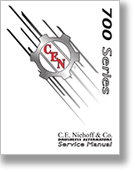
This is the factory service manual for Niehoff 700 Series alternators. It covers all aspects of service and repair.
ERA membership is required to download. Join Today!courtesy C.E. Niehoff & Co.
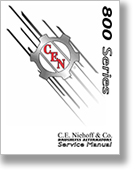
This is the factory service manual for Niehoff 800 Series alternators. It covers all aspects of service and repair.
ERA membership is required to download. Join Today!courtesy C.E. Niehoff & Co.

Rewinding simple stators
Unlike most other alternators, this Paris Rhone unit is two-phase, not three-phrase. This four-page article explains how the alternator works and presents a wiring diagram of the charging sustem.
It also shows all of the steps required to hand-rewind the stator (illustrated).
ERA membership is required to download. Join Today!by Bob Thomas

Five Guides To Solving PennTex Charging-System Problems
- Common Trouble Spots For Charging Systems
- How To Disassemble A PennTex Alternator
- How To Full-Field A PennTex Alternator
- How To Identify A PennTex Voltage Regulator
- Critical Voltage Points - "The Golden Triangle"
courtesy PennTex Industries, Inc.
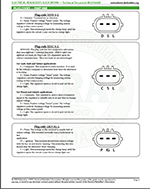
This 3-page document covers 11 different plug codes and 12 different test leads that share the same popular 3-pin oval Denso plug. All 12 configurations are explained in detail.
ERA membership is required to download. Join Today!by Scott Scharrer

Brush-Holder Ground Problem
This one-page guide discusses why it is not a good idea to replace a Powerline-specific brush holder with a standard Ford brush holder.
ERA membership is required to download. Join Today!by Bob Thomas

A smaller pulley will spin an alternator faster and improve output based on engine speed, but is it really a wise solution? 2-pages
ERA membership is required to download. Join Today!by Bob Thomas

Kohler
This three-page guide discusses how permanent-magnet alternator systems work and how to test the most common types. It deals specifically with a Kohler engine system that has a regulator-rectifier combination.
ERA membership is required to download. Join Today!by Wes Grueninger, Sr. and Bob Thomas

Demystifying the 4 types of Alternator Pulley Technologies
This presentation was given by Al Steadman (Litens Automotive) at the 2012 ERA Trade Show held in Allentown, PA. Topics include:
- Torsional Vibration
- Solid Pulleys and the dangers of using solid pulley technology
- Rubber Isolators
- OAPs (Overrunning Alternator Pulleys)
- Modified OAP Dangers
- Litens OAD (Overrunning Alternator Decoupler)
- How do I know which pulley to use?
- Removal and Installation video
- The 11231 alternator
courtesy Litens Automotive - Online Slideshow by Wes Grueninger, Sr.

This 4 page document covers how a pulse width modulation signal from the ECM is being used by Hyundai, Kia, Nissan and Suzuki to control voltage set point in their alternators, similar to GM and Ford but different.
ERA membership is required to download. Join Today!by: Gene Kaiser

This three-page article discusses how some manufacturers connect diodes to the stator wye-connection to increase alternator output. This article provides takes an in-depth look at the output, wave-patterns and other characteristics of wye terminals and how much extra output can be expected by rectifying wye-terminal output.
ERA membership is required to download. Join Today!by Bob Thomas and Wes Grueninger, Sr.

This 3-page article will show you how to convert a common Denso alternator into a tool which can be used to test most all types of voltage regulators.
ERA membership is required to download. Join Today!by Mohammad Samii

Here is a good example of out-of-the-box creative thinking—use a growler to test rotors! 1-page
ERA membership is required to download. Join Today!by Nathan Unger

Most rebuilders will test rotors with quick checks for shorts-to-ground and amperage draw. If the rotor looks good and passes both tests, it's reclaimed. If it fails either test, it's replaced. When a rotor does fail, it pays to take an extra minute to figure out why. In many cases, the bad rotor can be repaired and reused. This four-page guide will suggest a number of things you can check that might help you save an original OEM rotor. (976K PDF)
ERA membership is required to download. Join Today!by Wes Grueninger, Sr. and Bob Thomas

While a broken rotor coil lead is not something that you will run into very often, every rebuilder encounters one on occasion. 1-page
ERA membership is required to download. Join Today!by Bob Thomas

This 3-page article discusses why it is important to test certain rotors using the same polarity that will be used in the finished unit. Mando marine alternators are used as an example. If you have rebuilt a Mando marine alternator and it won't turn on, this article may have the answer!
ERA membership is required to download. Join Today!by Wes Grueninger, Sr. and Bob Thomas

This eight page guide contains test procedures, wiring diagrams and repair procedues for an 80A Sawafuji alternator on a 2000 UD Truck Model 2300-DH
ERA membership is required to download. Join Today!courtesy Ken Plourde

This two page article discusses why the OEMs attach each slip ring to a specific coil wire. Testing instructions about how to identify which lead goes to which slip ring are included. (204K PDF)
ERA membership is required to download. Join Today!by Wes Grueninger, Sr. and Bob Thomas

A quick way to remove a Denso stator from the alternator DE housing using an air hammer with a chisel tip. 1-page
ERA membership is required to download. Join Today!by Paul Tompert, Genco Auto Electric, Mesa, Ariz.

A quick way to remove a stubborn Ford stator from the alternator DE housing using a torch and hammer. 2-pages
ERA membership is required to download. Join Today!by Wes Grueninger, Sr.
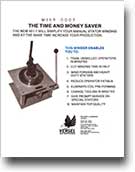
This 12 page guide shows the basics of hand-winding stators and the tools that are available to make the job easier.
ERA membership is required to download. Join Today!by Richard Vensel, Vensel Enterprises

This 2 page guide looks at the pros and cons of delta and wye stator configurations. It also shows how to convert a delta-wound stator to wye-wound. 2 pages
ERA membership is required to download. Join Today!by Bob Thomas and Wes Grueninger, Sr.

The Tech Basics series covers eight of the most popular charging systems. Each guide describes how system components work and interact. Wiring diagrams are included.
Tech Basics are available for:
- Ford (1G, 2G, 3G)
- Delco 10DN
- Chrysler External Regulator 1961-1987
- Lucas ACR
- AMC Motorola
- Honda/Toyota
by Wes Grueninger, Sr. - ERA Web Site Director

This three page article discusses the differences and similarities between trio-activated and stator-activated voltage regulators. Learn how to identify the two different systems and avoid the problems caused by mis-matching components.
ERA membership is required to download. Join Today!by Wes Grueninger, Sr. and Bob Thomas

This is a great reference guide—12 pages showing 443 Transpo voltage regulators and their terminal identification.
ERA membership is required to download. Join Today!courtesy WAIglobal

This document tells the story of two �re-manufactured� alternators from well known and respected rebuilders. Learn how they both ended up at my door and what I found inside.
ERA membership is required to download. Join Today!By Bob Thomas

From 1956, this military manual describes the then new 100 amp alternator charging system and also troubleshoots the entire system. This charging system features an external selenium rectifier and an alternator that could be submerged under water without damage! It's an interesting read even if you may never work on one of these.
ERA membership is required to download. Join Today!courtesy Vonnie Coke

CUCV 12/24 Volt Charging and Starting Systems
Confused by the 12/24 volt charging system on these vehicles? No more. This article offers a short history of the vehicles as well as detailed wiring diagrams. For more CUCV information, download the complete U.S. military manual listed below. (2,232K PDF)
ERA membership is required to download. Join Today!by Wes Grueninger, Sr.

Converting the 24-volt system to 12 volts
This guide describes how to convert the 24 volt portions of the CUCV electrical system to 12 volts. It offer two different types of conversions:
- Convert to a 12-volt system utilizing two batteries for starting power and one alternator for charging
- Convert to two 12-volt isolated systems. One system utilizing the two existing batteries and one alternator. The second system utilizing the other alternator and an additional battery.
- (1,660K PDF)
courtesy of the National Association of State Foresters and the Michigan Department of Natural Resources

This is all you've ever wanted to know, and more, about the Commercial Utility Cargo Vehicle (CUCV pronounced "cuck-vee"). A CUCV is a modified Chevy Blazer or GMC pickup produced from 1983 to 1986 for the U.S. military. This is the entire U.S. Military UNIT MAINTENANCE MANUAL (Warning - huge download - 940 pages! 14,962K PDF)
ERA membership is required to download. Join Today!courtesy U.S. Taxpayers

Some Valeo alternators incorporate a design that we will call a "floating stator" for lack of an actual manufacturer's term. The stators on these alternators are not held in position by fitting tightly into the end frames, as they are on most other alternators. These Valeo stators are held in place by bolts, or in some cases, by a hard rubber compound. All of these stators require exact alignment during unit assembly.
This guide will show an easy and quick way to perfectly center the rotor.
ERA membership is required to download. Join Today!by Bob Thomas

Creating a rectifier
Hitachi alternator LR180-03C will look familiar enough to anyone who has ever rebuilt any Hitachi external fan alternators. But what makes this alternator different from similar-looking automotive units is that it is isolated ground.
As of May, 2014 a replacement isolated-ground rectifier was not available from any known source. This two-page article will teach you how to convert a readily available rectifier to work in this unit and still retain an isolated-ground.
ERA membership is required to download. Join Today!by Bob Thomas

One-page parts breakdown for the Advanced DC Motors Starter-Generator - Includes contact information for ordering parts.
These units look almost exactly like the Hitachi starter-generators used on other golf carts. We also have a video, shot by Ken Plourde, that shows what to look out for when servicing these units.
ERA membership is required to download. Join Today!
From 1941. This Auto-Lite training manual has 62 pages full of rebuilding information for most all Auto-Lite generators and starters built before 1941. It includes specifications by unit number, as well as detailed rebuilding and testing information. (3.74mb PDF)
ERA membership is required to download. Join Today!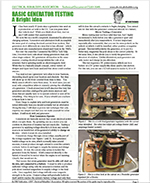
This document explains exactly how a generator operates on a vehicle and how you can quickly test it. If you are having problems getting a generator to work on a vehicle or on your test bench through a regulator, this document is for you. It explains how to make an inexpensive testing tool that works with any generator. The parts you need to make it are probably already in your shop.
ERA membership is required to download. Join Today!By Bob Thomas
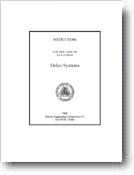
This 19 page manual is the official Delco publication for repair of the 1914 Junior Delco Starter-Generator system. This system was used on: 1914 Buick Models B-24-25, B-36-37—Cartercar Model 7—Hudson Model 6-40—Keeton Model 4-35—Oakland Model 36—Oldsmobile Model 42—Paterson Models 32-33—Westcott Model 0-4 (1.15mb PDF)
ERA membership is required to download. Join Today!courtesy Dan Poremba

This 22 page manual is the official Delco publication for repair of the 1914-1915 Delco Starter-Generator system. This system was used on: 1914 Buick B-55—1914 Cole Series 9—1915 Coles Series 10—1914 Moon 42, 6-50—1914 Oakland 43, 6-48, 6-60—1914 Oldsmobile 54 and 1915 Oldsmobile 55 (1.15mb PDF)
ERA membership is required to download. Join Today!courtesy John L. Prinvale - John's Automotive Electrical, Quincy, CA

From 1958. This 36-page full-color manual covers everything you ever wanted to know about how generators operate...and more! This is a long download - recommended for those with broadband.(2960K PDF)
ERA membership is required to download. Join Today!courtesy Henry Henke - United Starter and Alternator, Lowell, IN

Police Cars - Trucks - Taxicabs - Busses
From 1935. At first glance, you might think, "Why is this in the Technical Library," but don't let that keep you from reading this fascinating guide. It covers 2 brush and 3 brush generators and how they are regulated. The voltage regulator section explains how the current regulator and voltage regulator operate. Highly recommended to anyone seeking a better knowledge of how generators operate.(549K PDF)
ERA membership is required to download. Join Today!courtesy John L. Prinvale - John's Automotive Electrical, Quincy, CA
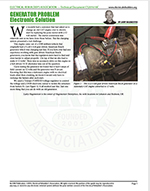
An outside-the-box solution for replacing a no longer available (NLA) regulator for a gear-driven American Bosch generator on a stationary engine.
ERA membership is required to download. Join Today!By: Larry Hagemeister

From 1963. This 8-page full-color manual covers testing and rebuilding motor-generators. Included are sections about the voltage regulator and wiring diagrams (1912K PDF)
ERA membership is required to download. Join Today!
Generator and Starter Breakdown and Parts List
Exploded diagrams show where all the parts go. Parts lists provide OE numbers and specs for most all parts. Four pages.
ERA membership is required to download. Join Today!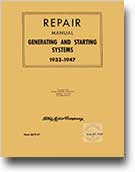
Generating and Starting Systems 1933-1947
This is a fantastic reference book if you are working on one of these old units. It has 39 pages of rebuilding and testing instructions along with OE parts breakdown and testing specifications.
ERA membership is required to download. Join Today!

Use this chart to determine if a generator your are working on is positive or negative ground, six or twelve volt, and what regulator should be matched to the generator for proper output.(6191K PDF)
ERA membership is required to download. Join Today!Provided by: Glen McLaughlin

This 6 page guide shows internal generator diagrams and testing data for 6V Harley-Davidson generators. Includes information for models: 32E, 32E2R, 48 (2 brush), 48 (3 brush), 51, 52, 52K and 52KH. (1.2mb PDF)
ERA membership is required to download. Join Today!provided by Vensel Enterprises

Hi-Resistance Brushes
This one-page article discusses how high resistance where the brush lead goes into the brush caused a charging problem. Also covered is how to test for very low resistance and how to make a tester to do so.
ERA membership is required to download. Join Today!by Nathan Unger

This 5 page article covers the most popular Hitachi/Mando golf-cart motor-generators. Circuit diagrams and current-flow explainations are included, along with bench testing instructions. Updated to Version 2.0, December 2010 (1.8mb PDF)
ERA membership is required to download. Join Today!by Wes Grueninger, Sr. and Bob Thomas
A wiring diagram for an EZ-GO G2A Golf Cart (with Hitachi motor-generator) is available to supplement this article.
ERA membership is required to download. Join Today!
These eight pages have some great diagrams as well as explain the different controls and talk about generator output. This collection covers the years from 1931 to 1937 and gives a great view of repair & service in that tough time.
Provided by: Glen McLaughlin
ERA membership is required to download. Join Today!ERA membership is required to download. Join Today!
ERA membership is required to download. Join Today!
ERA membership is required to download. Join Today!
ERA membership is required to download. Join Today!
ERA membership is required to download. Join Today!
ERA membership is required to download. Join Today!
ERA membership is required to download. Join Today!

This 10-page guide discusses how a Lucas regulator controls voltage and current. It also shows how to adjust a regulator to give proper output.
ERA membership is required to download. Join Today!
Have you ever found yourself in need of a set of generator coils that are no longer available? This seven-page article will guide you step-by-step and will teach you how to make a replacement set. Plans are included for a do-it-yourself winding machine.
ERA membership is required to download. Join Today!by Bob Thomas and Wes Grueninger, Sr.
Wire-Gauge Chart (referenced in the above article)
ERA membership is required to download. Join Today!

used on Dodge Brothers Vehicles
Dodge Brothers vehicles used a chain-driven starter/generator in the 1920's. This vintage guide shows how to rebuild the unit, install and adjust the chain and test the entire charging system.(2549K PDF)
ERA membership is required to download. Join Today!courtesy Wes Grueninger, Sr.

Chapter 1 - Components and Operation
This 3 page article, the first in a series on generator rebuilding, describes generator components and their basic operation. Included are diagrams and descriptions of "A" and "B" circuit generators. (1mb PDF)
Chapters:- Components And Operation
- The Field Circuit
- Are The Fields "A" or "B" Circuit
- Generators Are Self Exciting
- System Polarity - Positive or Negative Ground
by Wes Grueninger, Sr. and Bob Thomas

Chapter 2 - Generator Cutout Relays
This 5 page article, the second in a series on generator rebuilding, describes generator cutout relays and their operation. Included are diagrams and descriptions along with instructions on testing and adjusting. (1mb PDF)
Chapters:- How A Cutout Relay Works
- Testing Cutout Relays
- Adjusting Cutout Relays
- Electronic Cutout Relays
- Using A Diode To Repair A Conventional Cutout Relay
- Importance of Polarizing The Generator
by Wes Grueninger, Sr. and Bob Thomas

Chapter 3 - Testing and Reclaiming Generator Field Coils
This 5 page article, the third in a series on generator rebuilding, describes field coils. How to test and rewrap coils is covered in depth. Included are diagrams illustrating "A" circuit and "B" circuit systems. (1.2mb PDF)
Chapters:- Testing Field Coils
- Repairing and Salvaging Cloth- Or Paper-Wrapped Coils
- Shunt-Wound Field Coils
by Wes Grueninger, Sr. and Bob Thomas
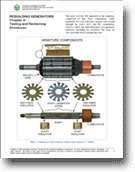
Chapter 4 - Testing and Reclaiming Armatures
This 10 page article, the fourth in a series on generator rebuilding, describes armatures. Armature design, theory of operation, testing, soldering, repairing and undercutting are covered in depth. Included are diagrams illustrating wave-wound and lap-wound circuits. (1.6mb PDF)
Chapters:- Armature Components
- Lap-Wound Armatures
- Wave-Wound Armatures
- Armature ID Summary
- Visual Inspection
- Testing For Grounds And Shorts
- Testing For Weak And Open Connections
- Re-soldering Weak Or Open Connections
- Turning and Undercutting
by Wes Grueninger, Sr. and Bob Thomas

Chapter 5 - Early Forms of Generator Regulation
—Including Third-Brush Generators
This 9 page article, the fifth in a series on generator rebuilding, describes how generator output was controlled before electromechanical voltage regulators, as we know them now, were used. Many different methods of limiting field current are shown. Third-brush generator magnetic theory, operation and adjustments are covered in detail. Included are diagrams illustrating field circuits and magnetic flux. (2.2mb PDF)
Chapters:- Manual Mechanical Regulation
- Automatic Mechanical Speed Controls (Governors)
- Inherent Method Of Regulation
- Third Brush (Field-Brush) Regulation
- Field Fuses and Circuit Breakers
- Testing Notes
by Wes Grueninger, Sr. and Bob Thomas

Chapter 6 - Generator Voltage Regulators
This 15 page article, the sixth in a series on generator rebuilding, describes the history and operation of generator voltage regulators.(3.7mb PDF)
Chapters:- Carbon-Pile Regulators
- Mercury-Tube Regulators
- Two-Unit Regulators
- Two-Unit Regulators with Combined Current-Voltage Relay
- Three-Unit Regulators
- Double Contact Regulators
- Electronic Regulators
- Polarizing
- How the Battery Affects Voltage
- Eight Volt Batteries
- Indicator Light
- Cleaning Relay Contacts
by Wes Grueninger, Sr. and Bob Thomas

Chapter 7 - Brushes, Brush Holders, Springs, Bearings, Bushings and Pulleys
This 8 page article, the seventh in a series on generator rebuilding, describes the "small, but important" components of a generator.(1.6mb PDF)
Chapters:- Generator Brushes
- Brush Holders and Brush Springs
- Pulleys and Means of Attaching
- Bearings and Bushings
- End Frames
- The Effects of Corosion
by Wes Grueninger, Sr. and Bob Thomas

This short article shows how to use a tap to extract a commutator-end bushing
ERA membership is required to download. Join Today!by ERE Staff

Included:
- Application Guide
- Exploded Diagram
- Parts List
- Mounting brackets and kits
Note: A companion guide, Wisconsin Motors Starters is available in the Starters section of the Tech Library
ERA membership is required to download. Join Today!courtesy Wisconsin Motors

Rebuilding Ford's Least Understood Starter.
ERA membership is required to download. Join Today!by Bob Thomas

Denso's Unique Fused Field Coils and How To Repair Them
ERA membership is required to download. Join Today!by Art Glass
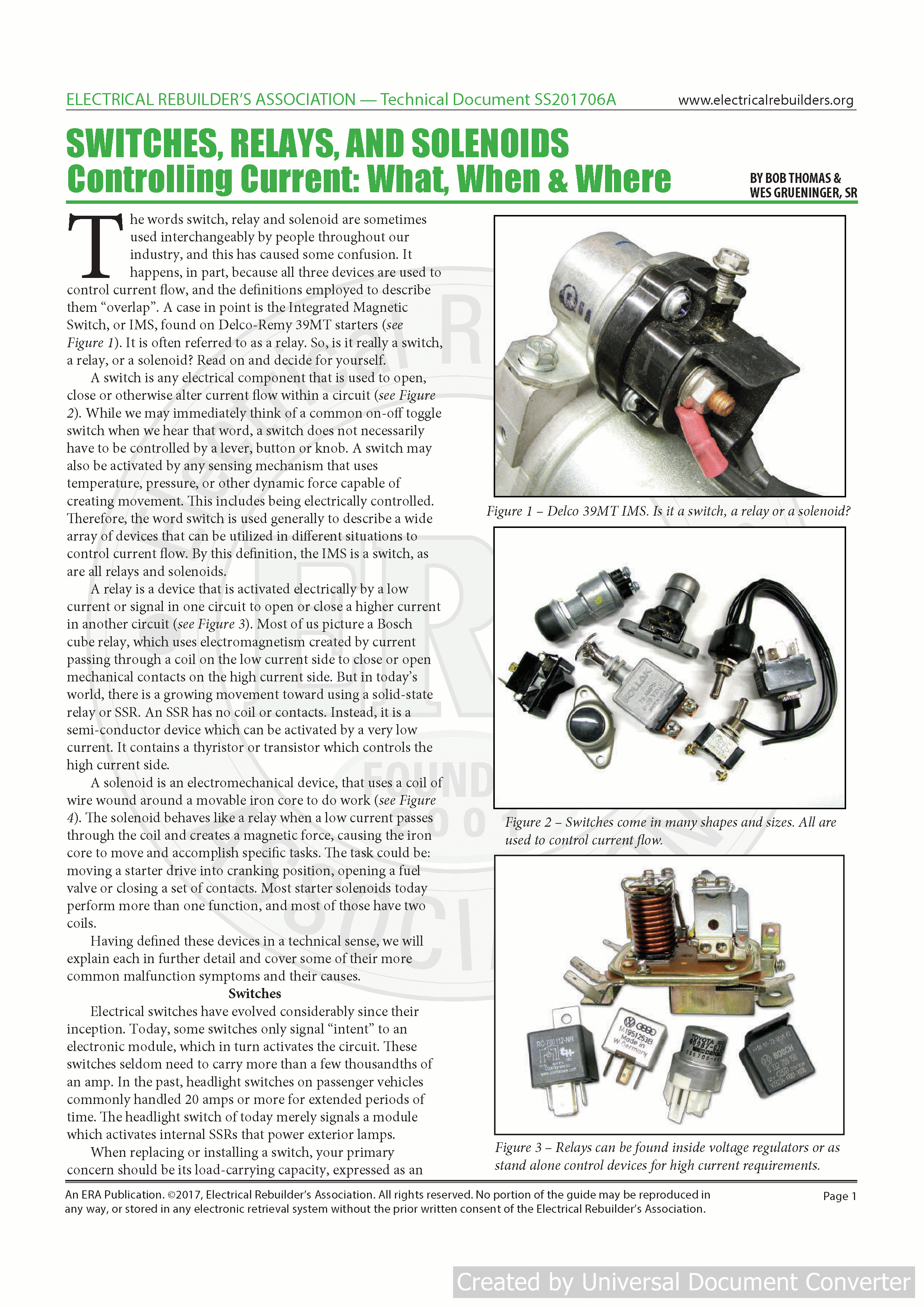
Controlling Current Flow � What, When & Where
ERA membership is required to download. Join Today!by Bob Thomas & Wes Grueninger, SR

What happens when contacts close
ERA membership is required to download. Join Today!by Bob Thomas & Wes Grueninger, SR

How Loads Affect Contacts
ERA membership is required to download. Join Today!by Bob Thomas & Wes Grueninger, SR

Using Diodes and Resistors to Protect DC Circuits
ERA membership is required to download. Join Today!by Bob Thomas & Wes Grueninger, SR

Delco's Smart IMS Relay Can Eliminate Most Customer-Caused Warranties
ERA membership is required to download. Join Today!by Bob Thomas
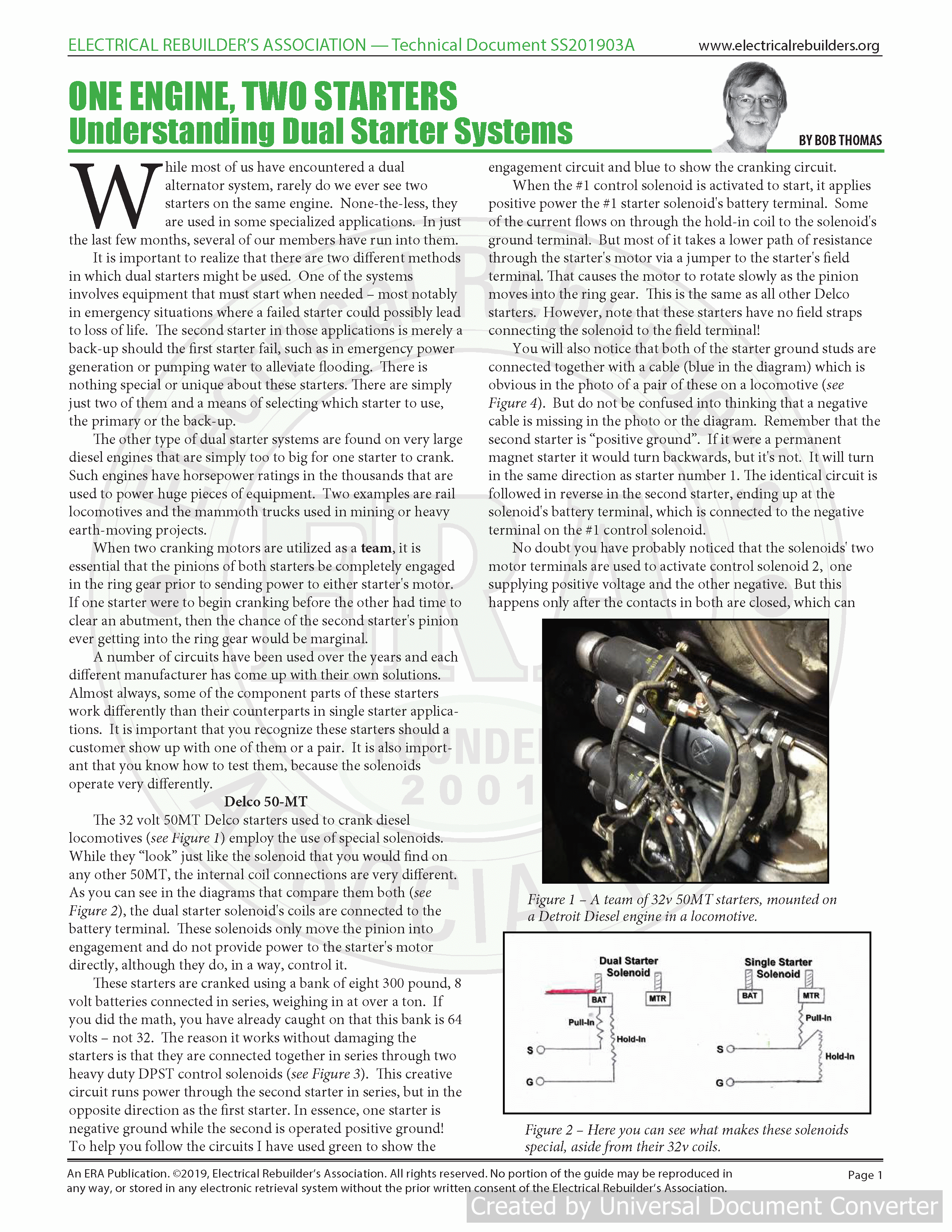
Dual Starter Applications and How They Work
ERA membership is required to download. Join Today!by Bob Thomas

CAT's Dual Starter Operates Differently
ERA membership is required to download. Join Today!by Daren Roggentien

Bosch 109 Series PMGR For Upgrading Diesel Applications
ERA membership is required to download. Join Today!by Bob Thomas

Loose Magnets Can Be Re-Installed Successfully
ERA membership is required to download. Join Today!by Bob Thomas

In this article, we will address two specific applications where poor alignment has affected our industry and, hopefully, provide you with some information that will help you if you encounter one of them.
ERA membership is required to download. Join Today!by Bob Thomas and Wes Grueninger, Sr.

This short article talks about a common mistake that can be made when working on a Declo Remy Type 400 50mt starter.
This article also inculdes a reference Chart that shows the difference with a 35 bar count and a 25 bar count on the 50mt Delco Armature.
ERA membership is required to download. Join Today!by Ken Plourde
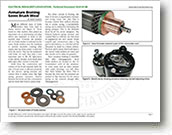
This two-page article discuses the importance of braking the armature after the engine starts. It also shows different armature braking systems that have been used by starter manufacturers.
ERA membership is required to download. Join Today!by Bob Thomas

Starter armature end play is the amount of horizontal or axial movement in the armature shaft after a starter is fully assembled. Some amount of end play is essential to prevent unwanted friction and binding during cranking, but excessive end play can cause many different problems, depending upon the particular starter. 1-page
ERA membership is required to download. Join Today!by Bob Thomas

How to take apart and rewind a small-motor armature. 6 pages
ERA membership is required to download. Join Today!by Bob Thomas

This article explains how the Bosch KB 416 & 417 starters operate and what to look for to avoid pitfalls when rebuilding them.
ERA membership is required to download. Join Today!by Bob Thomas

Written in February 2014, this 3-page article discusses the then-new Bosch soft-start style starter (0-001-261-025). Included are:
- A description of the starter, its component parts and how they work
- A wiring diagram of the starter and auxiliary relay
- Photos and dimensions of the starter
- A scope capture of current draw during starter activation
- Photos of the four-contact style solenoid used with this system
- A wiring diagram of the starter and solenoid
- Instructions and warnings about solenoid balance testing
by Nathan Unger (diagrams by Wes Grueninger, Sr.)

Some of the Asian made Briggs & Stratton replacement motors have a serious flaw. The negative brushes are not making good contact to ground. This article will tell you how to identify the problem. (21K PDF)
ERA membership is required to download. Join Today!
This PDF includes five B&S factory bulletins:
- Electric Starter Quick Reference Guide #1—lists engine model → starter → gear → drive assembly
- Electric Starter Quick Reference Guide #2—lists engine model → starter → gear → drive assembly
- Electric Starter/Pinion Gear Update—Model Series 161400 thru 461700 (with aluminum or plastic flywheel ring gears)
- Touch-N-Mow Starting System—120000 Quantum& Intek Vertical Shaft
- 12 Volt Starter Motors (P/N 497595 & 497596)—Sticking Pinion Gears
courtesy Briggs & Stratton (sent in by Ray VanDervort)
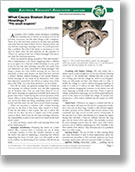
This 2-page article discusses the causes of and the cures for broken starter drive-end housings. Topics covered include:
- Improper Installation
- Cranking with higher voltage
- Failed Start
- Starting Fluid
- Ignition Timing
- Ring-gear-to-pinion-clearance
by Bob Thomas
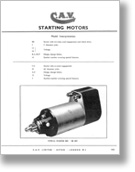
C.A.V. starter parts breakdown for BS524, SP5, CA45 models.
ERA membership is required to download. Join Today!
C.A.V. starter repair manual for CA45D and CA45F models.
ERA membership is required to download. Join Today!
This short article discusses how a Lester #18203 (S114-414) stater will replace a ZT76-414 China-made tractor starter.
ERA membership is required to download. Join Today!by Larry Hagemeister
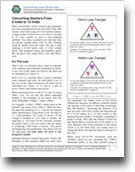
When conversion coils aren't available, this 5-page article shows how to convert parallel 6-volt field coils to safely work with 12 volts. Performing this conversion helps to prevent damaged and jammed drives as well as cracked drive-end housings.
ERA membership is required to download. Join Today!by Bob Thomas and Wes Grueninger, Sr.
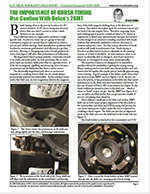
This document explains the importance of starter brush timing with particular attention to original and aftermarket Delco 28MT's. Being close with brush timing is not good enough.
ERA membership is required to download. Join Today!By Bob Thomas

Broken Drive Housings
This 2-page bulletin from Delco-Remy covers the causes of broken drive-end housings and the corrections needed to prevent further breakage.
ERA membership is required to download. Join Today!courtesy Hank Henke - United Starter and Alternator

Exposed Shift-Lever Cranking Motors
This 8-page service manual from Delco-Remy covers the theory and operation of exposed shift-lever starters. It includes sections on troubleshooting the cranking circuit, testing, disassembly, inspection and repair. It also describes how to measure and how to set pinion clearance.
ERA membership is required to download. Join Today!
This 5-page guide from Accumax discusses 35MT starter solenoids and shifter forks. It points out the problems that can be caused by using a too short aftermarket shifter fork with an OE-style solenoid. Solutions and adjustment procedures are included.
ERA membership is required to download. Join Today!courtesy Robbie Sullivan - Accumax

Solenoid Substitution on 35MT Starters with Exposed Shift Levers
If you should find yourself rebuilding a 30MT or 35MT starter with an exposed shift lever, you will quickly realize that most of the parts are NLA (no longer available). This one-page guide will show you how to use a later-style D985 (Accurate 951) solenoid to replace the NLA original solenoid.
ERA membership is required to download. Join Today!by Bob Thomas

This 1-page guide from Accumax discusses how aftermarket solenoid plunger springs with too many coils can cause chattering. Illustrations show how to tell good springs from bad springs.
ERA membership is required to download. Join Today!courtesy Robbie Sullivan - Accumax

Standard and Semi-Solid Link Solenoids Interchange
This chart lists the current Delco 37, 41 and 42MT switches and the Delco Semi-Solid link equivalents.(66K PDF)
ERA membership is required to download. Join Today!by Scott Fureman - Purfex Electrical Distributors

The first time most rebuilders are confronted with a 41MT series Delco Remy starter, they probably think they've got a 37MT starter. From the outside, the two look exactly the same at first glance. While they are very similar and share some applications, they are not the same, nor are the internal parts universally interchangeable. Some of the differences are obvious after you take the starters apart. Others are not. This four-page, fully illustrated document explains the differences between the two starters.
ERA membership is required to download. Join Today!by Wes Grueninger, Sr. and Bob Thomas

A rebuilder's friend or foe?
The Delco-Remy 39MT has been around since the beginning of the new millennium, but some rebuilders still admit to feeling uncomfortable working on it. Delco-Remy has made a number of changes to this starter since it first appeared, and these changes have caused much of the confusion and problems that have been associated with the 39MT ...
ERA membership is required to download. Join Today!by Wes Grueninger, Sr. and Bob Thomas

How To Seal the DE Housing Against Rock Dust
This 1-page guide shows how to install a Federal-Mogul seal in the DE housing to prevent dust from getting behind the drive and causing disengagement problems.
ERA membership is required to download. Join Today!courtesy Tom Barrett, Dakota Battery and Electric

This is the most complete source of 50MT rebuilding information ever published. It's 132 pages full of drawings and information, including:
- Theory of Operation
- Repair Parts, Special Tools and Equipment
- Troubleshooting
- Cleaning
- Disassembly
- Repair
- Assembly
- Operational Testing
- Waterproof Test
courtesy U.S. Government

From 1957. This excellent 24-page full-color manual covers all aspects of starter operation - circuits, drives, solenoids, maintenance and testing. Includes a section on how series-parallel switches work.(2232K PDF)
ERA membership is required to download. Join Today!courtesy Jim Morton - Peoria Electric, Corvallis, OR

Minimum and maximin "free speed" specifications for 28MT, 29MT, 37MT, 38MT, 39MT HD, 42MT and 50MT starters.
ERA membership is required to download. Join Today!courtesy Bob Jefferies - Delco Remy Of America

This short article is to make you aware of a manufacturing defect in some aftermarket PG260 replacement starter drives.
ERA membership is required to download. Join Today!by Walter Beacham

Installing Delco External Shift Lever Springs
This short article illustrates a quick and easy way to align and install those pesky springs.
ERA membership is required to download. Join Today!by Bob Thomas

This four-page article explains how to replace the tracking gear and rebuild the starter drive on this unique starter. Instructions are included that explain how to make a tool to open the starter drive cap.(880K PDF)
ERA membership is required to download. Join Today!by Wes Grueninger, Sr. and Bob Thomas
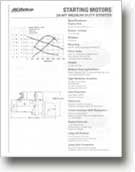
for 28, 37, 41, 42, 50 MT Starters
This article contains spec sheets from AC-Delco about many heavy-duty MT series starters.(923K PDF)
ERA membership is required to download. Join Today!courtesy Dick Vensel - Vensel Enterprises

While the Delco semi-solidlink (SSL) solenoid has been in use for well over a decade now, some rebuilders who have not been involved in the heavy duty market are just beginning to see them, and more than a few have asked us how to separate the plunger from the solenoid. Most rebuilders who know how to do this, have probably already formed an opinion about this solenoid's benefits, be it right or wrong.
This article will attempt to clear up some of the misconceptions about the SSL solenoid, explain the science behind it, and hopefully prove that there are real advantages to using it.
ERA membership is required to download. Join Today!by Bob Thomas and Wes Grueninger, Sr.

The Denso drive, with a pinion gear too big to pass through the drive-end housing, is probably the least favorite drive from which to remove the retaining ring. Special tools are available for this job, but if you don't have one handy when you need it, this article will show you how to remove the ring with a simple bolt and two screwdrivers.
ERA membership is required to download. Join Today!by ERA Staff
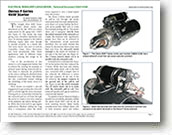
One of the peculiarities of this starter is a soft-engagement feature that is achieved by rotating the armature at reduced speed during solenoid pull-in. This helps to eliminate the possibility of the pinion milling the flywheel when abutment occurs. However, this feature has also contributed toward making the rebuilding of this starter more of a challenge.
This 8-page article how to identify and test the components of this unique system.
ERA membership is required to download. Join Today!by Bob Thomas and Wes Grueninger, Sr.

This document explains the operation of Denso's PA90S diesel starter and how you can rebuild them successfully.
ERA membership is required to download. Join Today!by Bob Thomas

This document covers a number of rebuilding tips for the Denso permanent magnet - planetary gear starter used on numerous Toyota, Pontiac and Subaru vehicles up to 3.5L.
ERA membership is required to download. Join Today!by Bob Thomas

This 2-page article describes in words and diagrams how to set proper pinion clearance on starters equipped with dyer drives.
ERA membership is required to download. Join Today!courtesy Hank Henke - United Starter and Alternator

The M8T50071 Mitsubishi starter, often referred to by its Lester number, 17578, was used by Ford on 7.3L Power Stroke™ diesels. from 1994 until 2001, when Ford switched to Visteon starters for its Power Stroke™ diesels. This 3 page article discusses the problems that can arise when mixing parts from different versions of this starter.
ERA membership is required to download. Join Today!by Bob Thomas and Wes Grueninger, Sr.

This chart lists Ford Starter interchange from Direct Drive through the latest PMGR styles.
*** Updated 10/2013 ***
ERA membership is required to download. Join Today!by Scott Fureman - Purfex Electrical Distributors

This article provides illustrated, step-by-step instructions how to replace a Ford direct-drive starter with a Ford PMGR starter. It's meant to printed on both sides of letter-sized paper and then folded to create a pamphlet. Great to hand to customers or include in a box with the unit. For a complete listing of PMGR replacement units see the tech article Ford Starter Interchange Guide listed below.(329K PDF)
ERA membership is required to download. Join Today!courtesy Wes Grueninger, Sr.

Ford did make a shim in the 1970's and it is still available in the aftermarket. This document explains when and how to use them and where you can buy them.
ERA membership is required to download. Join Today!by Larry Hagemeister

This article discusses early and late style shifter forks used in Ford PMGR starters and how to install and interchange them.
ERA membership is required to download. Join Today!by Bob Thomas and Wes Grueninger, Sr.

The sound of a cranking starter sent adrenaline pumping into his heart. Was someone trying to steal his berry harvester!
He yanked the covers off and, still in his pajamas, ran out there as fast as his bare feet would go. When he reached the machine parked beside the barn, the starter was still cranking but no one was there...
by Nathan Unger

This document covers everything that you need to know about brushes, including their manufacturing process, content, electrical loads, spring tension, wear patterns and resistivity vs voltage.
ERA membership is required to download. Join Today!by Bob Thomas

Cranking Problems Caused By Bad Ground Inside Starter Motor
One common problem seen in all versions of this starter has been a poor ground connection, similar to that seen in many other starters with bimetal connections in the ground path.
This 3-page article shows how to repair the bad ground connection and treat it with corrosion inhibitor to ensure long starter life.
ERA membership is required to download. Join Today!by Bob Thomas
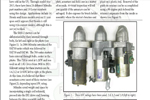
This 7-page article talks about the Mitsuba Honda Starter SM612, 710, 730, and 740 Series. Step by step with photographs explaining the process of changing and re-installing.
ERA membership is required to download. Join Today!by Bob Thomas

This one-page bulletin describes how starter kick-back occurs on the 3.0L GM and 2.0L Mazda engines. It also details how a delay timer will fix the problem. (39K PDF)
ERA membership is required to download. Join Today!courtesy of Hyster
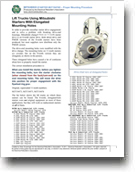
Mitsubishi Starter M3T10476D—Proper Mounting Procedure
This one-page bulletin describes the mounting procedure for Mitsubishi starters with elongated mounting holes. It's great to hand out to any of your customers that repair lift trucks.
ERA membership is required to download. Join Today!by Wes Grueninger, Sr.
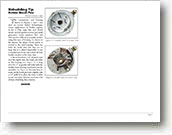
This one-page article shows how to keep the brushes retracted on UT starters used on some Kohler engines.
ERA membership is required to download. Join Today!by Vonnie Coke
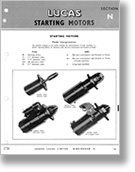
This OE Lucas guide shows parts and specs for M35, M45, M325 and M418 starters.
Includes:- Brushes and dimensions
- Drive numbers and specifications (teeth, direction, dimensions, shaft size)
- CE Plate numbers
- DE Housing numbers
- Solenoid numbers and specifications

This one-page article shows how a seemingly good looking ground stud can be hiding a voltage-drop problem that will prevent proper starter operation. Fixes and preventive maintenance are discussed in detail
ERA membership is required to download. Join Today!by Bob Thomas

Pinion clearance is probably one of the least understood calibrations required in rebuilding starters. It is critical to the proper operation of Lucas M50 and M127 starters. These starters in particular, are the most difficult in which to set the precise clearance.
This five-page article will show you step-by-step how to properly adjust pinion clearance on these starters. It also shows how to make a handy tool for tightening the jamb nut on the shift pin.
ERA membership is required to download. Join Today!by Bob Thomas
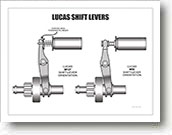
This one-page drawing shows the correct installed position of the shift lever on Lucas M127 and M50 starters. It's great to print and hang on the wall by your starter assemby station!
ERA membership is required to download. Join Today!by Wes Grueninger, Sr.

This eight-page article explains in detail exactly how Lucas M50 starters implement "soft-start" to prevent drive milling. Complete with many wiring diagrams and pictures, this article will help you to understand, and to successfully rebuild, these starters.
ERA membership is required to download. Join Today!by Nathan Unger and Wes Grueninger, Sr.
The Lucas M50 factory manual from 1972 is available to supplement this article.
ERA membership is required to download. Join Today!
Permanent magnets in starters & DC motors
Often taken for granted unless they are broken, permanent magnets have played an important part in the development of the compact and powerful starter motors seen today. Aside from being damaged by the shock of a hammer blow, field magnets have proven to be quite durable and long lasting. However, that has not always been the case, because the permanence of some magnets can be compromised under certain circumstances ...
ERA membership is required to download. Join Today!by Bob Thomas

If you've taken apart a Mitsuba 17870 starter and need help figuring out how all the parts go back together, this handy chart is just what you need!
ERA membership is required to download. Join Today!courtesy Metro Auto Inc.
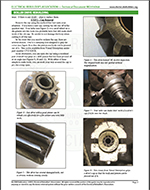
This 5-page article by Richard Vensel explains how you can economically rebuild roller drive clutches in low volume with a minimal investment in parts and equipment.
ERA membership is required to download. Join Today!by Dick Vensel

Replacing a denso starter with a start relay attached. A perfect example of customer service.
ERA membership is required to download. Join Today!By Ken Plourde

Cranking Problem
This starter was used on Nissan, TCM and CAT forklifts on at least 14 different models that we are aware of. A problem is caused by two factors that combine to create a no-crank condition or a weak engagement. These conditions have damaged ignition switches from excessive loads and have damaged pinion gears or flywheel ring gears from weak engagement. This article show how to fix the problem using a Bosch relay.
ERA membership is required to download. Join Today! CAT TSB (referenced in the above article)
ERA membership is required to download. Join Today!
by Bob Thomas

Verify the seals in your rebuilt starter before it leaves the shop. This 1-page article will tell you how to build a pressure tester.
ERA membership is required to download. Join Today!by Nathan Unger
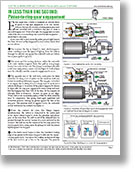
Pinion-to-ring-gear engagement
Every single time a starter is energized, an intricate dance of pinion-to-ring gear engagement is set into motion. Within a fraction of a second, a rotating pinion gear must mate smoothly with a stationary ring gear to create a successful engine start. When all is right, this engagement succeeds 100% of the time. It is something that most of us take for granted ... until it fails to take place.
If you were able to slow down the entire process and observe the chain of events as they happened in slow motion, this is what you would see...
ERA membership is required to download. Join Today!by Bob Thomas and Wes Grueninger, Sr.

The precise position of spiral stater brush springs that are used in many starter motors is of critical importance. This documents explains why and what happens when the tension is not perfectly centered.
ERA membership is required to download. Join Today!by Bob Thomas

This three-page article argues the case that Prelub™ starters should always be rebuilt and not replaced with a conventional starter. Included are photos of the comm-end-oil-pump assembly, a wiring diagram and a description of how the system works.
ERA membership is required to download. Join Today!by Bob Thomas and Wes Grueninger, Sr.

What's next?
You have no doubt heard of alternators being controlled via pulse width modulation (PWM). Well, now they are making starters that are controlled that way, too. There is already at least one starter that we are aware of that operates in this manner (see Figure 1). It is manufactured by Valeo, #D7ED281 (cross-referenced to Lester #33244 and Mercedes #1661510001). This starter is equipped with a Valeo solenoid, #594463 (cross-referenced to Wagner #W452-24N). This starter fits 1998 and newer 1.4L and 1.6L Mercedes A-Class vehicles. Although the A-Class is not yet sold in the U.S. or Canada, the technology will show up here eventually—if not on the A-Class, then on a different Mercedes model or another brand of vehicle. ... (3 pages)
ERA membership is required to download. Join Today!by Nathan Unger and Bob Thomas

This five-page article explains how a starting circuit can be damaged when solenoid contacts wear out. It also explains how the pull-in and hold-in coils of a solenoid work. Instructions on performing a voltage-drop test of the starter "S" circuit are included.(691K PDF)
ERA membership is required to download. Join Today!by Wes Grueninger, Sr. and Bob Thomas
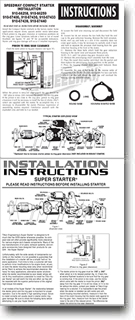
Installation and Shimming Instructions
These are the instruction sheets included with Tilton and Speedway starters. They explain how to use shims to set the pinion at-rest clearance as well as the pinion engagement clearance.
ERA membership is required to download. Join Today!ERA membership is required to download. Join Today!
courtesy Speedway and Tilton

Installing Tight Snap Rings
Among the most difficult snap rings to re-install are those used on Bosch industrial starters. If you have a 3-jaw puller, this can be an easy job. This also works with any other drive that has a flat surface under the drive body for the jaws to hook onto.
ERA membership is required to download. Join Today!by Bob Thomas

This 4-page illustrated article describes the interplay of a solenoid's hold-in coil and pull-in coil during the starting cycle.
The importance of coil balance is discussed and a test procedure is presented.
ERA membership is required to download. Join Today!by Wes Grueninger, Sr. and Bob Thomas

Where and Why?
This article describes solenoid cap vents used with OE Delco and aftermarket solenoids and why it is important to use always replace a vented solenoid with a vented solenoid. Two-pages.
ERA membership is required to download. Join Today!by Bob Thomas

Prevent Broken Caps
This one-page PDF can be printed and cut into four customer handouts. It explains the recommended way to tighten the battery stud nut without cracking the cap. It also has the disclaimer that "broken caps are not covered under warranty". Protect your profits by giving one of these out with every starter that you sell.
ERA membership is required to download. Join Today!by Bob Thomas

A shunt coil is simply a field coil connected directly to the battery in parallel with the armature, as opposed to being connected in series with the armature, as most starter field coils are.
Shunts have been used in many different starters in combination series field coils and sometimes cause confusion or misunderstanding for rebuilders.
Why is the shunt coil there, what does it really do and how does it work? This 4 page article will explain it all.
ERA membership is required to download. Join Today!by Wes Grueninger, Sr.

Screw-Type Drives
This 4-page article starts by examining the very first starter drives. It explains where the brand name Bendix comes from and how it came to by synonymous with "starter drive."
"Bendix springs" are covered in detail, including the reasons for their failure. The article also includes a discussion of damage that can occur to a drive by running a 6V starter on 12V.
ERA membership is required to download. Join Today!by Bob Thomas and Wes Grueninger, Sr.

Barrel-Type Drives
This well illustrated 3-page article discusses barrel starter drives. Topics include:
- Facet Enterprises "Folo-Thru" drive
- How to disassemble the drives
- How the locking mechanism works
- Locking pin release speed
- Spring dampening vs. rubber-cushion dampening
- Inboard and outboard mounting
- Different means of fastening the drive to the armature
by Bob Thomas and Wes Grueninger, Sr.

Roller-Clutch Drives
This 5-page article covers roller-clutch starter drives. Topics include:
- History and design of the over-running roller clutch
- How a roller-clutch drive works
- Proper lubrication
- Rebuilding tips and techniques
- Rebuilding Denso OSGR drives
- Different styles of roller-clutch drives
- Contact info for parts and tools
by Bob Thomas and Wes Grueninger, Sr.
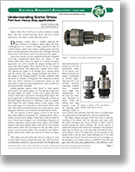
Heavy Duty Applications
This 4-page article covers dyer, sprag and Positork starter drives. Topics include:
- History and design of the Dyer starter drive
- How a Dyer drive works
- Sprag drives: design and function
- History and design of the Positork starter drive
by Bob Thomas and Wes Grueninger, Sr.
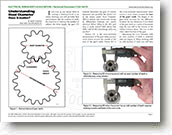
Understanding Root Diameter
If you look up any starter drive in a catalog, a reference book or an online database, you will probably find specifications like the number of teeth, the direction of rotation, the number of splines, the drive length, the gear OD (outside diameter), the gear ID (inside diameter) and possibly the drive's OD at the widest point. Root Diameter (RD) is seldom ever mentioned, except to differentiate between two nearly identical drives. What is the RD, and does it really matter? Will drives that differ only by RD interchange with one another? These questions and more are answered in this two-page article.
ERA membership is required to download. Join Today!by Bob Thomas and Wes Grueninger, Sr.
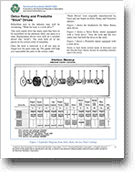
This style starter drive has many parts that have to be assembled on the armature shaft, one piece at a time. Replacement drives were sold on a wooden dowel (the "stick"). The stick held all of the pieces in the correct order of assembly.
Once the stick is removed, it is all too easy to forget how the parts stack up. This guide will help you reassemble the parts in the correct order.
ERA membership is required to download. Join Today!by Wes Grueninger, Sr.
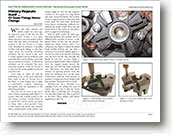
History Repeats Itself ... Or Some Things Never Change
This short article covers a melting problem with some aftermarket UT (United Technologies) style brush holders. It presents a quick test that you can use weed out the bad ones before they can cause problems.
ERA membership is required to download. Join Today!by ERE Staff

Included:
- Application Guide
- Exploded Diagram
- Parts List
- Mounting brackets and kits
- Covers models: ABN, ACN, ACN, ADH, AEH, AEHS, AEN, AENL, AFH, AGH. AGND, AHH, AKN, BKN, BKN, S10D, S12D, S14D, TE, TF, TH, THD, TJD, V465D, VE4, VE4D, VF4, VG4D, VH4D, W2-1230, W2-1235, W2-1250, W2-880, W4-1770
Note: A companion guide, Wisconsin Motors Generators and Alternators is available in the Generators section of the Tech Library
ERA membership is required to download. Join Today!courtesy Wisconsin Motors

Different Types of Corrosion and How You Can Limit Their Effects ERA membership is required to download. Join Today!
by Bob Thomas

Superconductors Explained � What Are They and Where Are They Used ERA membership is required to download. Join Today!
by Bob Thomas

Everything You Need to Know About Magnet Steel and What Makes It Different ERA membership is required to download. Join Today!
by Bob Thomas
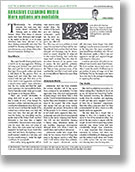
More options are availabl Traditionally, the rebuilding industry has used steel shot media almost exclusively for cleaning parts in airless shot blasters. While other forms of abrasive media have been developed and brought to the market in the last 15 to 20 years, rebuilders have been reluctant to try them. Feeling comfortable with what "has worked" for decades, and failing to look at new alternatives, is not always what is best for your business in the long run. ... (2 pages) ERA membership is required to download. Join Today!
by Bob Thomas

This 3 page Technical Document, by Jim Rinaudo, talks about using a Minitune device and upgrading it.
ERA membership is required to download. Join Today!By: Jim Rinaaudo

This 4 page installation guide, by Sure Power Industries, offers detailed instructions on wiring up battery isolators. It includes detailed wiring diagrams for most domestic and import vehicles, including:
- Ford (1985 and later 2G)
- Ford (1998 and later 3G )
- General Motors CS and CS130D
- Toyota
- Honda
- Bosch Systems
courtesy of Sure Power Industries, Inc..

This slide show was presented by Exide Technologies at the 2013 ERA Show in Indianapolis, Ind. It covers the Exide line of batteries, offers marketing tips and shows the design, characteristics and structure of AGM batteries. 54 slides.
ERA membership is required to download. Join Today!courtesy Exide Technologies. - Slideshow by Wes Grueninger, Sr.

This document, written by Jim Rinaudo, contains step-by-step instructions on how you can build your own constant power supply, which can be used for testing any number of alternator, starter or generator components.
ERA membership is required to download. Join Today!by Jim Rinaudo
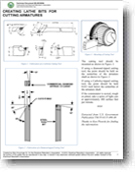
One-page guide shows how to create diamond-tipped or Carboloy cutting tools and how to properly position them for the best armature cutting. Even if you are not creating your own cutting tools, using the angles shown in this guide when resharpening existing bits will result in improved cutting. (282Kb PDF)
ERA membership is required to download. Join Today!by Wes Grueninger, Sr.

Inch sizes only
This handy chart shows frational-to-decimal drill sizes, what size hole to drill for a given thread and sheet metal screw-hole sizes
ERA membership is required to download. Join Today!courtesy Hank Henke

This three-page document describes how current flows through a stud-to-terminal connection and the importance of selecting fasteners that will carry the current without problems. It examines various combinations of nuts and lock washers and shows which have the most current carrying capacity.
ERA membership is required to download. Join Today!by Bob Thomas and Wes Grueninger, Sr.

This three-page document specifies the product requirements required to quality for the labels "Used," "Secondhand," "Repaired," "Remanufactured," "Reconditioned," and "Rebuilt,". (PDF)
ERA membership is required to download. Join Today!by U.S. Government

Perhaps the most important tool you'll use in troubleshooting auto electrical systems is the multimeter. This interactive slide show teaches how to use a multimeter. Topics include:
- Batteries
- Alternators, Alternator AC Leakage
- Starter Current, Circuit Resistance
- Ohm's Law, Voltage Drop
- Ford BP/MAP Sensor, Feedback Carburetor, Fuel Pressure
- Throttle Position Sensor, Ignition Coils
- Condensers, Hall-Effect Position Sensors
- Magnetic Position Sensors, RPM
- Rear Window Grid Defogger
- Duty Cycle, Temperature Measurement
- Locating Current Drains, Bad Grounds
- Spark Plug Wires
courtesy Fluke Corp. - Slideshow by Wes Grueninger, Sr.

This document explains how you can test the voltage saturation (Vsat) of some regulators with the alternator running on your test bench. Examples are provided for both A and B circuit regulators.
ERA membership is required to download. Join Today!by Gene Kaiser

Generator & Starter Armatures, Alternator Stators & Rotors
The inside cover describes this manual as follows:
"The International Products and Manufacturing Company's No. 36-37FO1 Preformed Armature Coil Winding Information Manual is the most comprehensive and complete passenger car, light and heavy truck, tractor, off the road equipment, foreign car, outboard marine, motorcycle, light and heavy alternator stator winding data ever compiled for the armature rewinders.
Over thirty-five years of painstaking research and records by the Experimental and Research Department of International Products & Manufacturing Co., of their armature winding data and compilation are incorporated into this valuable manual. In fact, invaluable and no rewinding shop is complete without it.
Pertinent winding information, data and armature component part numbers of Delco-Remy, Autolite, Chrysler, Ford, Prestolite, Leece-Neville, Ducellier, Fiat, Simca, Renault Dauphine, German Bosch Volkswagen, Delco-Remy and Autolite Outboard Marine Armatures are listed. Also, Delco-Remy and Chrysler passenger car and heavy duty alternator stator winding and hook-ups."
ERA membership is required to download. Join Today!provided by Richard Vensel, Vensel Enterprises

Alternators and Starters
First Published October, 1993. All charts are ready to print on letter-sized paper (8.5" x 11"). They are a great learning tool for new employees. Use them for parts reference - write on your own part numbers and display on wall. They can help to organize inventory.
Click here to go to the IPM Wall Chart sectioncourtesy of NRG Auto Systems/IPM, Cicero, IN

The "24-Volt, Split-Ground"
The 24-volt split-ground electrical system used on John Deere 730, 820, 830, 3020, 4010 and 4020 tractors with diesel engines and electric start from 1958 to 1968 is probably the least understood and most confusing system ever created. This 5-page guide discusses every aspect of the charging, starting and lighting systems. Wiring diagrams of the starting/charging and the lighting system are included.
ERA membership is required to download. Join Today!by Wes Grueninger, Sr. and Bob Thomas

Alternators and Starter Motors
Published in 2005, this 664-page manual is an amazing source of rebuilding information. It's like taking a how-to-rebuild course for some of the most popular alternators and starters. Each unit section is divided into two parts: theory of operation and repair instructions. Contents include:
Alternators- Delco-Remy Alternators: 10SI, 12SI, 15SI
- Motorola Alternators: 8E, HC, MA, MR, A, RA, 8AR, SA, TA
- Niehoff Alternators: 12V-110A, 24V-50A
- Denso Alternators: External and Internal Regulated Units
- Bosch Alternators
- Valeo Alternators: A13N
- Magneton Alternators
- Leece-Neville Alternators
- Prestolite Alternators
- Iskra Alternators
- Delco-Remy Starters: 10/20/22/25/27/28/30/35/37/40/41/42/50MT
- Denso Starters: Conventional, Gear Reduction, Planetary
- Bosch Starters: Conventional, Planetary
- Iskra Starters: AZE, AZF, AZJ
- Valeo Starters
- Magneton Starters
courtesy John Deere Power Systems

This document explains how a light emitting diode (LED) works and why it is better than a filament bulb. Creating a brighter light while using less current. You can retrofit most older vehicles with LED lights for extra income. They are an excellent choice for trailer lighting because they are unaffected by drops in voltage.
ERA membership is required to download. Join Today!By: Bob Thomas

In the 1930s the LeJay Manufacturing Company started publishing a series of articles about converting then common automotive generators into all kinds of useful items. These items were primarily meant to be used by rural dwellers where electricity was not available. This manual, from 1945, contains 50 plans.
This manual is not only a testament to how clever the designers were, but it is an education in how generators are constructed. Learn how to hand rewire an armature and how to wind your own field coils!
Partial Contents:- 110V A.C. Light Plant made from Ford Model "T" Generator
- 75 to 110 Ampere Arc Welder Made From Dodge 'G' or 'GA' Generator
- An Electric Outboard Motor from Old Ford 'T' Generator
- An Armature Growler from a Ford Model 'T' Generator
- A Drill Press from a 'T' Generator
- A Battery Spot Welder
- A Direct Drive 32 Volt Wind Plant - All Metal Construction
- An Electric Scooter using a Ford Model 'T' Generator
- An A.C. Welding Transformer Using Dodge Generator Coils

This 1-page chart explains the number grouping of the Lester Catalog system.
ERA membership is required to download. Join Today!courtesy Dennis Jacinto, Lester Catalog Company
Also in this library: Pic Codes5 Explained

This 9-page instruction guide describes how the entire Low Voltage Thermal Switch system works. Includes a wiring diagram and manual override instructions
ERA membership is required to download. Join Today!courtesy MAXON Lift Corporation

The guide was produced by Mitsubishi Electric Automotive America, Inc. While it specifically deals with Mitsubishi HD alternators and starters, it also offers good training on electrical basics. There is a very good explanation of what voltage drop is and how to perform voltage drop tests.(1,009K PDF)
ERA membership is required to download. Join Today!courtesy Mitsubishi Electric Automotive America, Inc.

Key-off parasitic drain on a vehicle's battery is becoming an ever increasing problem, as auto manufacturers continue to add electrical gadgets and the modules needed to control them. This 3-page article explains how to test for key-off parasitic battery drain, what equipment you will need, and common problems that cause parasitic drain.
ERA membership is required to download. Join Today!by Bob Thomas

Removing Rusty Pole Shoe Screws
From chemicals to heat, this article explores solutions to removing stubborn pole-shoe screws. 2-pages
ERA membership is required to download. Join Today!by Bob Thomas

Electrical System Preventive Maintenance and Diagnostic Procedures
The 24-page manual from Prestolite Electric contains:
- Characteristics of HD electrical systems
- The Battery system and testing
- The Charging system and testing
- The Starting system and testing
- Alternator sizing worksheet
courtesy Prestolite Electric

This booklet explains the purpose and the installation of an Orpin (series-parallel) switch on top of a special battery comprised of two 6V batteries. At the peak of their popularity in the 40s and 50s, these switches and batteries can still be found on classic cars.(PDF)
ERA membership is required to download. Join Today!courtesy John Prinvale

This one-page guide provides an explanation of how to use the PIC numbering system.(PDF)
ERA membership is required to download. Join Today!courtesy Dennis Jacinto - Lester Catalog Company
Also in this library: Lester Numbering System Explained

Which ground is best?
This one-page article looks at positive ground systems and discusses why they were phased out in favor of negative ground systems. The discussion includes a look at positive ground's effect on:
- Corrosion
- Contact Wear
- Electronics
- Spark Plugs
by Bob Thomas

One-page guide shows how to use a tap to remove blind-end bushings from housings. (186Kb PDF)
ERA membership is required to download. Join Today!by Bob Thomas

- or -
Four Handy Uses for Bosch Relays
This seven-page guide details four problem solving uses for small relays, commonly referred to as "Bosch Relays". It starts with a close-up look at the inside and the pinouts of the relays, and goes on to explain, along with detailed wiring diagrams, how to:
- Repair Low Voltage at Starter S Terminal
- Create a Starter Lock-Out
- Control Charge Light in a Positive-Ground 10SI System
- Limit Voltage Drop to Accessories
by Wes Grueninger, Sr. and Bob Thomas

- or -
Reversing bidirectional motor using two SPDT Bosch relays
PROBLEM: You have a small bidirectional, permanent magnet, DC motor that must be momentarily operated in different directions by reversing current flow through the motor. This motor could be powering a small pump or a gear driven mechanism.
SOLUTION: Use two SPTD relays and a momentary three-position toggle or rocker switch so that each direction of the motor is activated by one relay. This two-page article shows you how.
by Bob Thomas and Wes Grueninger, Sr.

This three-page article explains different methods that can be use to remove rusted pole-shoe screws from generators and starters. Topics covered are:
- Removing with chemicals
- Removing with heat
- Removing with impact drivers
- Removing with pole-shoe fixtures
- Removing with drills
by Bob Thomas

What They Are And What They Can Do
Retaining compounds are a category of products that can be used to secure a cylindrical assembly, such as a bearing or a bushing, to a housing—or to attach a pulley or inner bearing race to a shaft. Having these compounds around when you need them can be invaluable to any rebuilder. 3-pages
ERA membership is required to download. Join Today!by Bob Thomas

Electrical Circuits
This 64-page book starts with a very good explanation of basic electrical principles and troubleshooting. It also includes many pages of Rolls-Royce-specific wiring diagrams and repair tips. It was originally published by the Rolls-Royce Owners Club in 1969.
ERA membership is required to download. Join Today!courtesy Glen McLaughlin

Generators, Regulators, Cut-Outs and Batteries
This 33-page book starts with a very good explanation of how a generator produces electricity and goes on to explain how the entire Rolls-Royce charging system works. It was originally published by the Rolls-Royce Owners Club in 1970.
ERA membership is required to download. Join Today!courtesy Glen McLaughlin

What Works Where, Why and How
This two-page article looks at the basics of solder and soldering. It includes:
- What solder is, how it works and what it is made of.
- Solder melting range and why it is important.
- Solders ingredients and how they affect tensile strength.
- Acid flux and rosin flux
- Lead-free 97/3 solder and its advantages
by Bob Thomas

This one-page article updates the article above. It includes:
- A disadvantage of 97/3 lead-free solder.
- Solder melting range and why it is important.
- Alternatives to 97/3 solder.
by Bob Thomas

How to solder using a 12V battery as the power source. 1-page
ERA membership is required to download. Join Today!by Richard Vensel
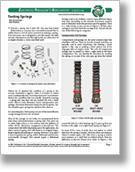
This four-page guide discusses the different types of springs used in our industry: Compression springs, Extension springs, Torsion springs, Flat-form springs, Wire-form springs and Constant-pressure springs. The importance of correct spring tension is covered, as well as a guide to making your own spring tension tester.
ERA membership is required to download. Join Today!by Wes Grueninger, Sr. and Bob Thomas

This document explains exactly what �voltage saturation� means and why it is so important. This can help you test and identify a salvageable working regulator based on its Vsat.
ERA membership is required to download. Join Today!by Gene Kaiser

Installing Delco Snap Rings
The only tool you need to install the Delco snap ring is the old starter drive and a small hammer.
ERA membership is required to download. Join Today!by Bob Thomas

External Thread Repair Options -
Files, Dies, Chasers And Special Tools
A look at the various tools and processes to restore external threads. 2-pages
ERA membership is required to download. Join Today!by Bob Thomas

Valve Guide Brushes
A faster, easier and safer way to clean all mounting holes without removing good aluminum is by using a modified set of valve-guide brushes and a drill. 1-page
ERA membership is required to download. Join Today!by Bob Thomas

Valeo Alternator Tool
This Thomas & Betts cutter forces the blade against a flat surface. That flat anvil surface is what makes it work so well at breaking welded stator connections on all types of alternators without damaging the rectifier lead frame. 1-page
ERA membership is required to download. Join Today!by Bob Thomas

This two-page chart shows torque values for inch and metric fasteners.
ERA membership is required to download. Join Today!
This one-page chart shows torque values for metric fasteners. It also includes a tap-drill size chart.
ERA membership is required to download. Join Today!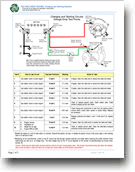
Common problems can be detected
This two-page guide is designed as a quick course in voltage-drop testing. It's perfect to give to a customer that you suspect may have voltage-drop problems. You can build goodwill and save time! It's also a good introduction to voltage-drop testing for new employees.
Page One gives a concise explanation of how voltage-drop testing works.
Page Two includes a wiring diagram of a generic charging and starting system with voltage-drop test points clearly labeled.
Page Two also includes a series of 10 tests, that if followed in sequence, will find the voltage drops in the high-current circuits.
by Wes Grueninger, Sr. and Bob Thomas

WAI has made their entire collection of Technical Updates available online. Lots of good information available on everything from rebuilding basics to the latest units.
Click here to go to the WAI Technical Update section
courtesy WAI

This 1-page article talks about appling silicone paste inside a connection
ERA membership is required to download. Join Today!by Dan Marinucci

Understanding H-Bridge Circuits
with wiring diagrams for popular winch motor circuits
This 7-page guide discusses how direction reversing of DC-motors is accomplished. It includes generic wiring diagrams for popular winch motor circuits and detailed diagrams of two popular Warn winch solenoid packs.(2.3MB PDF)
ERA membership is required to download. Join Today!by Wes Grueninger, Sr.

American Wire Gauge, or AWG, is the standard wire gauge system that has been used in the United States and Canada since 1857. It is based on the cross-sectional area of solid, nonferrous, electrical conducting wire, and is an important factor in determining current-carrying capacity. While we have all seen various AWG charts for determining gauge size, there has been much misunderstanding about how that applies to different types of wire and cables. We will try to set the record straight by explaining some science behind copper conductors, how wire is made, what determines the gauge size and how all of that affects current flow. 2-pages
ERA membership is required to download. Join Today!by Bob Thomas
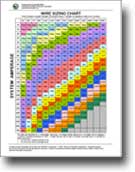
This one-page guide will help you figure out what gauge wire to use for a given amperage load and wire length.
ERA membership is required to download. Join Today!courtesy Bob Thomas - B&H Electric
Posted by: faucet-kitchens.blogspot.com
Source: https://www.electricalrebuilders.org/techlib/tech_lib_search.php